
One of the best parts about gearing up for any sort of race is the pre-starting line pasta party. Part of the grain food group, pasta takes its place among other carb-heavy favorites such as bread, rice and oatmeal. The U.S. Department of Agriculture (USDA) states that women should get six ounce equivalents of grains in a day, while men should get eight.
Half of those should be whole grains, per the Academy of Nutrition and Dietetics. Most Americans have little difficulty eating enough grains according one March 2014 study published in Nutrition Research, but rather it's eating whole grains can be a game-changer. According to a June 2016 review published in the British Medical Journal, three-servings of whole grains can reduce the risk of chronic diseases and premature mortality.
Video of the Day
Video of the Day
So how do you know how much is the right amount? When it comes to pasta, measuring out your serving size before you cook it is a pretty foolproof way to prevent overeating. Measure it out after it's cooked, and it will be a little harder to handle and you may find you made a little too much.
Read more: 7 Tricks to Adjust to Smaller Portions of Food
Proper portion control can be tricky when you're dealing with packaged foods. While most boxes of pastas show a serving size as two ounces of dry pasta (or one cup of cooked pasta), the USDA recommends preparing one ounce of uncooked pasta (or a half-cup cooked) as an "ounce equivalent." Here's how to get that portion size right.
With a Scale
1. Get the Right Scale
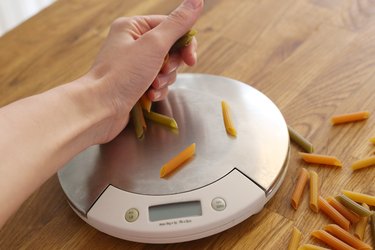
Use a digital or spring scale to measure your pasta. Add dry pasta to the scale a little at a time to get the Goldilocks amount.
2. Add Slowly to Get the Right Serving Size
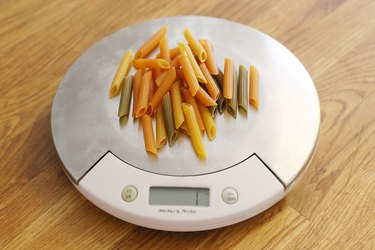
Stop adding pasta when the scale reads 1 ounce (or 30 grams) if you want to adhere to the USDA's serving size recommendation.
With Measuring Cups
Reach for the Right Size Tool
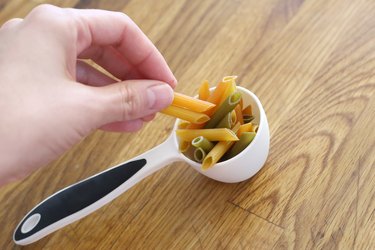
Use the 1/8 cup to ration out a one ounce serving size of pasta and a 1/4 cup size for a two ounce serving.
Increase Proportionately to How Many You're Serving
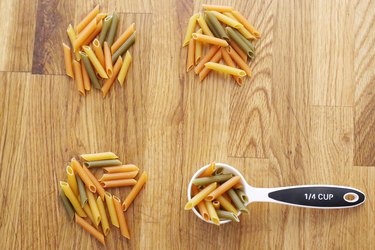
Cook for more than one person and multiply your serving sizes by 1/8 or 1/4 cups.
With Your Hands
Find the Right Diameter
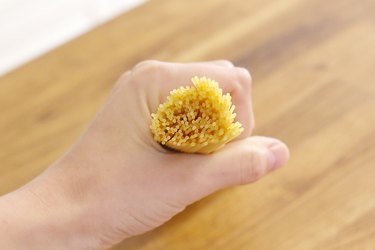
Measure long strand pasta with your hands. The small grouping should measure roughly an inch-and-a-half in diameter. This equals eight ounces of dry pasta.
Separate Out Portions in Advance
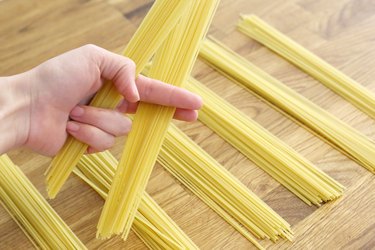
Divide the pasta into eight equal sections to get the USDA serving size recommendation. Use one section per serving. Go with four equal sections if you want to adhere to the two ounce serving size recommendation.
New Pasta Varieties
The pale pasta options we grew up with has plenty of competition on the shelves now. With everything from whole wheat to lentil and chickpea varieties available, the general assumption is that you can eat larger amounts of these "better for you" pastas. While they may be healthier picks, they shouldn't be considered "all you can eat" options.
Read more: 10 Must-Try Noodle Alternatives
"Chickpea or lentil pasta can be a great alternative due to their higher protein and fiber content," says registered dietitian Hailey Crean, a certified diabetes educator in Connecticut, who adds swapping in lentil and chickpea pasta may make you feel fuller for longer thanks to their fiber content. "However, I still recommend sticking to the same portion size goal, as their total calorie content is very similar [to traditional pasta], approximately 200 calories in 2 ounces. "
Tip
- Pasta cooking times vary among shapes and types, so always read the instructions.
- Save time by weighing and bagging individual servings for multiple meals at once.
- If your portion of pasta feels skimpy, especially when compared to what you're used to getting in restaurants, just bulk it up, suggests Crean. "Try a drizzle of a flavorful extra virgin or pesto sauce, broccoli crowns, chopped red peppers, fresh tomatoes, olives, or mushrooms."
- MyPlate: "What Foods Are in the Grains Group?"
- Academy of Nutrition and Dietetics: "What is a Whole Grain?"
- British Medical Journal: "Whole grain consumption and risk of cardiovascular disease, cancer, and all cause and cause specific mortality: systematic review and dose-response meta-analysis of prospective studies"
- Nutrition Research: "Total dietary fiber intakes in the US population are related to whole grain consumption: results from the National Health and Nutrition Examination Survey 2009 to 2010"